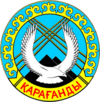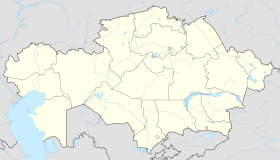Karaganda
|
Karaganda Қарағанды (Kazakh) |
||
|---|---|---|
| City | ||
| Karagandy | ||

Statue of Nurken Abdirov in Karaganda
|
||
|
||
| Location in Kazakhstan | ||
| Coordinates: 49°50′0″N 73°10′0″E / 49.83333°N 73.16667°ECoordinates: 49°50′0″N 73°10′0″E / 49.83333°N 73.16667°E | ||
| Country | Kazakhstan | |
| Region | Karaganda Region | |
| Founded | 1931 | |
| Government | ||
| • Akim (mayor) | Nurlan Aubakirov | |
| Area | ||
| • Total | 497.8 km2 (192.2 sq mi) | |
| Elevation | 546 m (1,791 ft) | |
| Population (1 January 2010) | ||
| • Total | 459,778 | |
| • Density | 920/km2 (2,400/sq mi) | |
| Time zone | ALMT (UTC+6) | |
| Postal code | 100000 - 100030 | |
| Area code(s) | +7 7212 | |
| Vehicle registration | M and 09 (region) | |
| Website | karaganda-akimat |
|
Karaganda or Qaraghandy (Kazakh: Қарағанды/Qarağandı/قاراعاندى [qɑɾɑˈʁɑndə]), more commonly known by its Russian name Karaganda (Russian: Караганда, until 1993), is the capital of Karaganda Region in Kazakhstan. It is the fourth most populous city in Kazakhstan, behind Almaty (Alma-Ata), Astana and Shymkent. Population: 459,778 (2009 Census results); 436,864 (1999 Census results).
In 1940, up to 70% of the city's inhabitants were ethnic Germans. Most of the ethnic Germans were Soviet Volga Germans who were collectively deported to Siberia and Kazakhstan on Stalin's order when Hitler invaded Soviet-annexed eastern Poland and the Soviet Union proper in 1941. Until the 1950s, many of these deportees were interned in labor camps, often simply because they were of German descent.
The population of Karaganda fell by 14% from 1989-1999 following the dissolution of the Soviet Union; it was once Kazakhstan's second-largest city after Almaty. One hundred thousand people have since emigrated to Germany. There is also a concentration of ethnic Poles in the city.
This is the home city of Kazakh World War II hero Nurken Abdirov. A statue in Abdirov's honor is located in the center of the city.
Karaganda is located 200 km South-East from Kazakhstan's capital Astana.
The name "Karaganda" is derived from "caragana" bushes (Caragana arborescens, Caragana frutex), which are abundant in the area.
...
Wikipedia


